Essay on European Union Law
VerifiedAdded on 2021/02/19
|9
|2675
|44
AI Summary
Contribute Materials
Your contribution can guide someone’s learning journey. Share your
documents today.
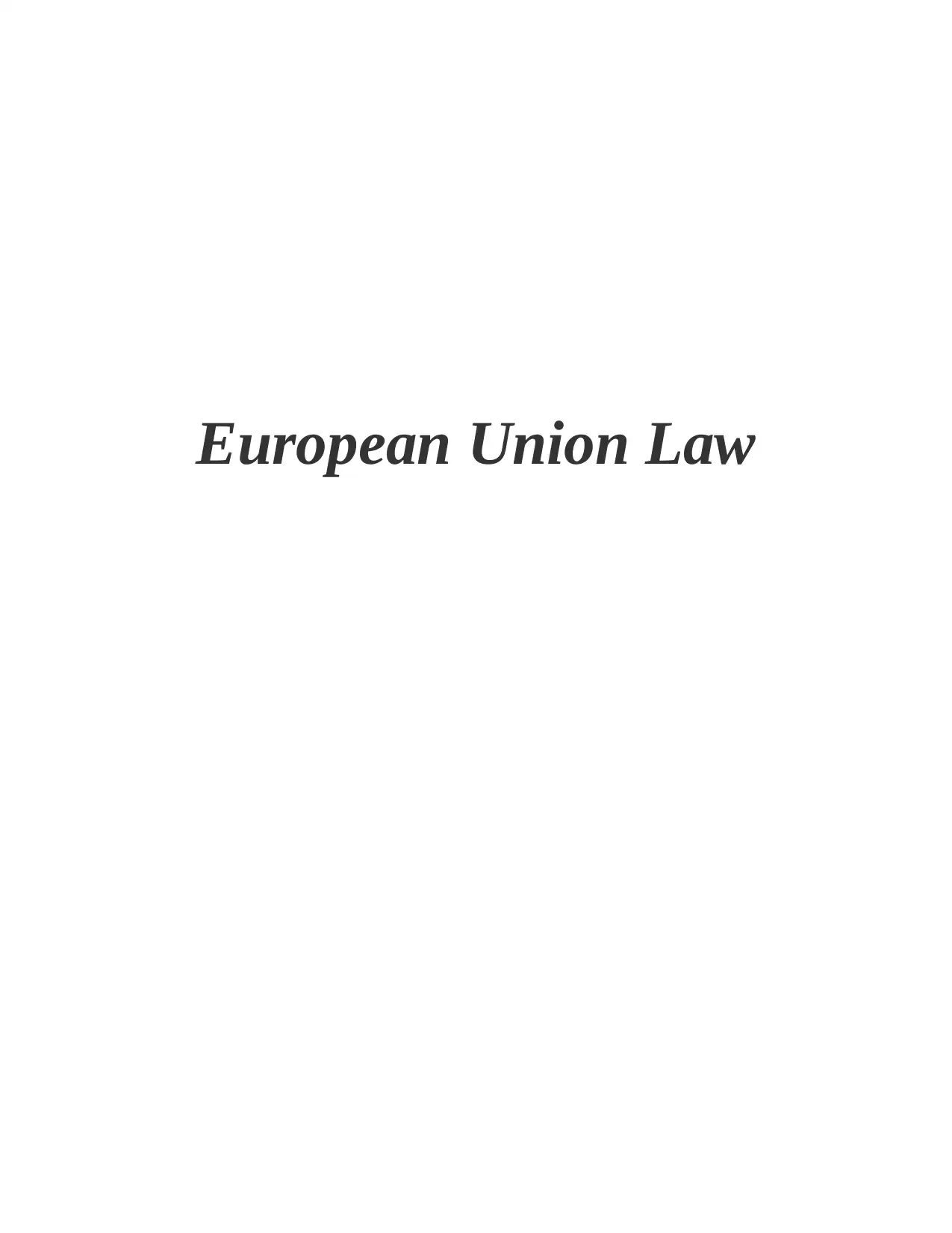
European Union Law
Secure Best Marks with AI Grader
Need help grading? Try our AI Grader for instant feedback on your assignments.

Table of Contents
INTRODUCTION...........................................................................................................................1
MAIN BODY...................................................................................................................................1
CONCLUSION................................................................................................................................4
SUMMARY.....................................................................................................................................5
REFERENCES................................................................................................................................6
INTRODUCTION...........................................................................................................................1
MAIN BODY...................................................................................................................................1
CONCLUSION................................................................................................................................4
SUMMARY.....................................................................................................................................5
REFERENCES................................................................................................................................6
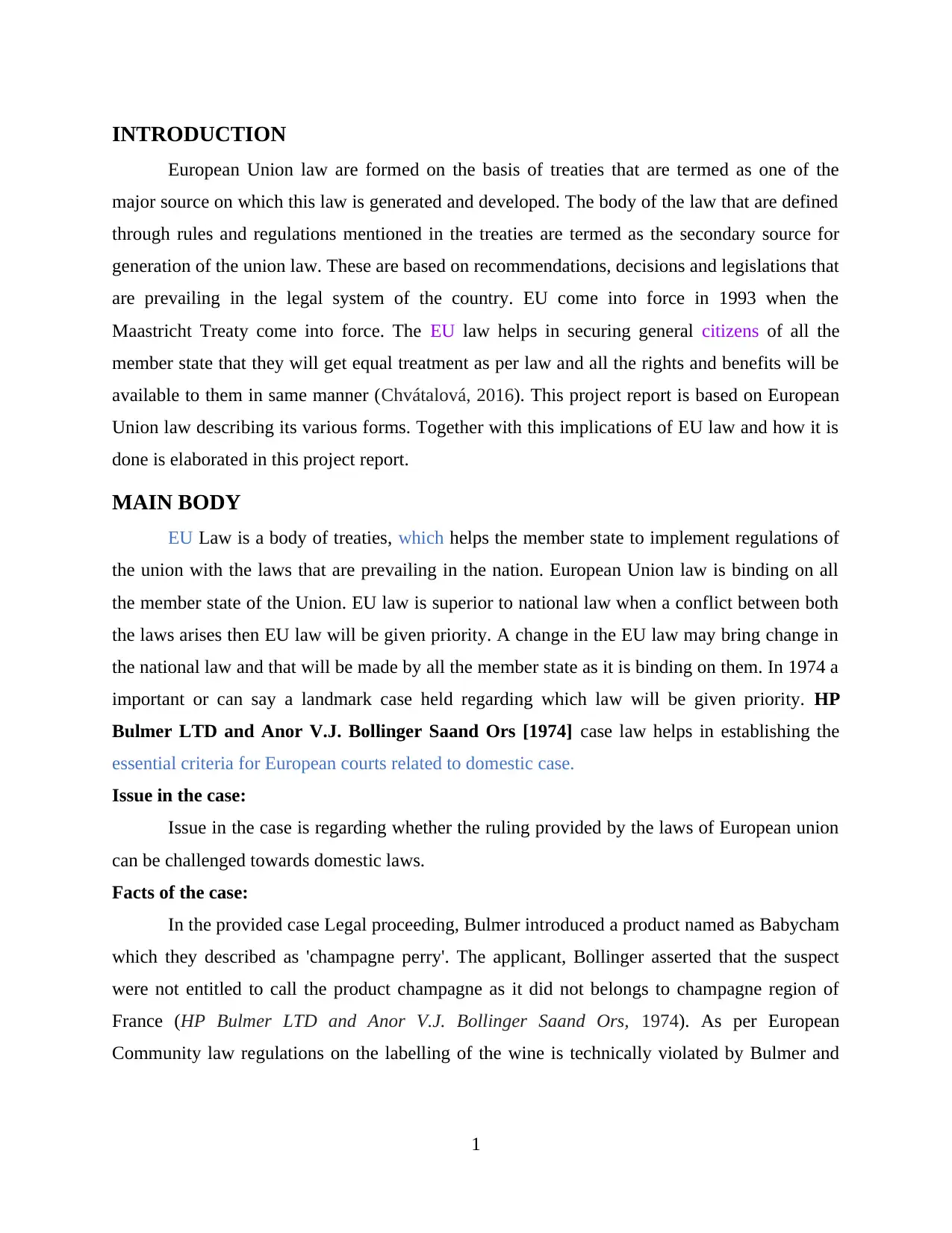
INTRODUCTION
European Union law are formed on the basis of treaties that are termed as one of the
major source on which this law is generated and developed. The body of the law that are defined
through rules and regulations mentioned in the treaties are termed as the secondary source for
generation of the union law. These are based on recommendations, decisions and legislations that
are prevailing in the legal system of the country. EU come into force in 1993 when the
Maastricht Treaty come into force. The EU law helps in securing general citizens of all the
member state that they will get equal treatment as per law and all the rights and benefits will be
available to them in same manner (Chvátalová, 2016). This project report is based on European
Union law describing its various forms. Together with this implications of EU law and how it is
done is elaborated in this project report.
MAIN BODY
EU Law is a body of treaties, which helps the member state to implement regulations of
the union with the laws that are prevailing in the nation. European Union law is binding on all
the member state of the Union. EU law is superior to national law when a conflict between both
the laws arises then EU law will be given priority. A change in the EU law may bring change in
the national law and that will be made by all the member state as it is binding on them. In 1974 a
important or can say a landmark case held regarding which law will be given priority. HP
Bulmer LTD and Anor V.J. Bollinger Saand Ors [1974] case law helps in establishing the
essential criteria for European courts related to domestic case.
Issue in the case:
Issue in the case is regarding whether the ruling provided by the laws of European union
can be challenged towards domestic laws.
Facts of the case:
In the provided case Legal proceeding, Bulmer introduced a product named as Babycham
which they described as 'champagne perry'. The applicant, Bollinger asserted that the suspect
were not entitled to call the product champagne as it did not belongs to champagne region of
France (HP Bulmer LTD and Anor V.J. Bollinger Saand Ors, 1974). As per European
Community law regulations on the labelling of the wine is technically violated by Bulmer and
1
European Union law are formed on the basis of treaties that are termed as one of the
major source on which this law is generated and developed. The body of the law that are defined
through rules and regulations mentioned in the treaties are termed as the secondary source for
generation of the union law. These are based on recommendations, decisions and legislations that
are prevailing in the legal system of the country. EU come into force in 1993 when the
Maastricht Treaty come into force. The EU law helps in securing general citizens of all the
member state that they will get equal treatment as per law and all the rights and benefits will be
available to them in same manner (Chvátalová, 2016). This project report is based on European
Union law describing its various forms. Together with this implications of EU law and how it is
done is elaborated in this project report.
MAIN BODY
EU Law is a body of treaties, which helps the member state to implement regulations of
the union with the laws that are prevailing in the nation. European Union law is binding on all
the member state of the Union. EU law is superior to national law when a conflict between both
the laws arises then EU law will be given priority. A change in the EU law may bring change in
the national law and that will be made by all the member state as it is binding on them. In 1974 a
important or can say a landmark case held regarding which law will be given priority. HP
Bulmer LTD and Anor V.J. Bollinger Saand Ors [1974] case law helps in establishing the
essential criteria for European courts related to domestic case.
Issue in the case:
Issue in the case is regarding whether the ruling provided by the laws of European union
can be challenged towards domestic laws.
Facts of the case:
In the provided case Legal proceeding, Bulmer introduced a product named as Babycham
which they described as 'champagne perry'. The applicant, Bollinger asserted that the suspect
were not entitled to call the product champagne as it did not belongs to champagne region of
France (HP Bulmer LTD and Anor V.J. Bollinger Saand Ors, 1974). As per European
Community law regulations on the labelling of the wine is technically violated by Bulmer and
1
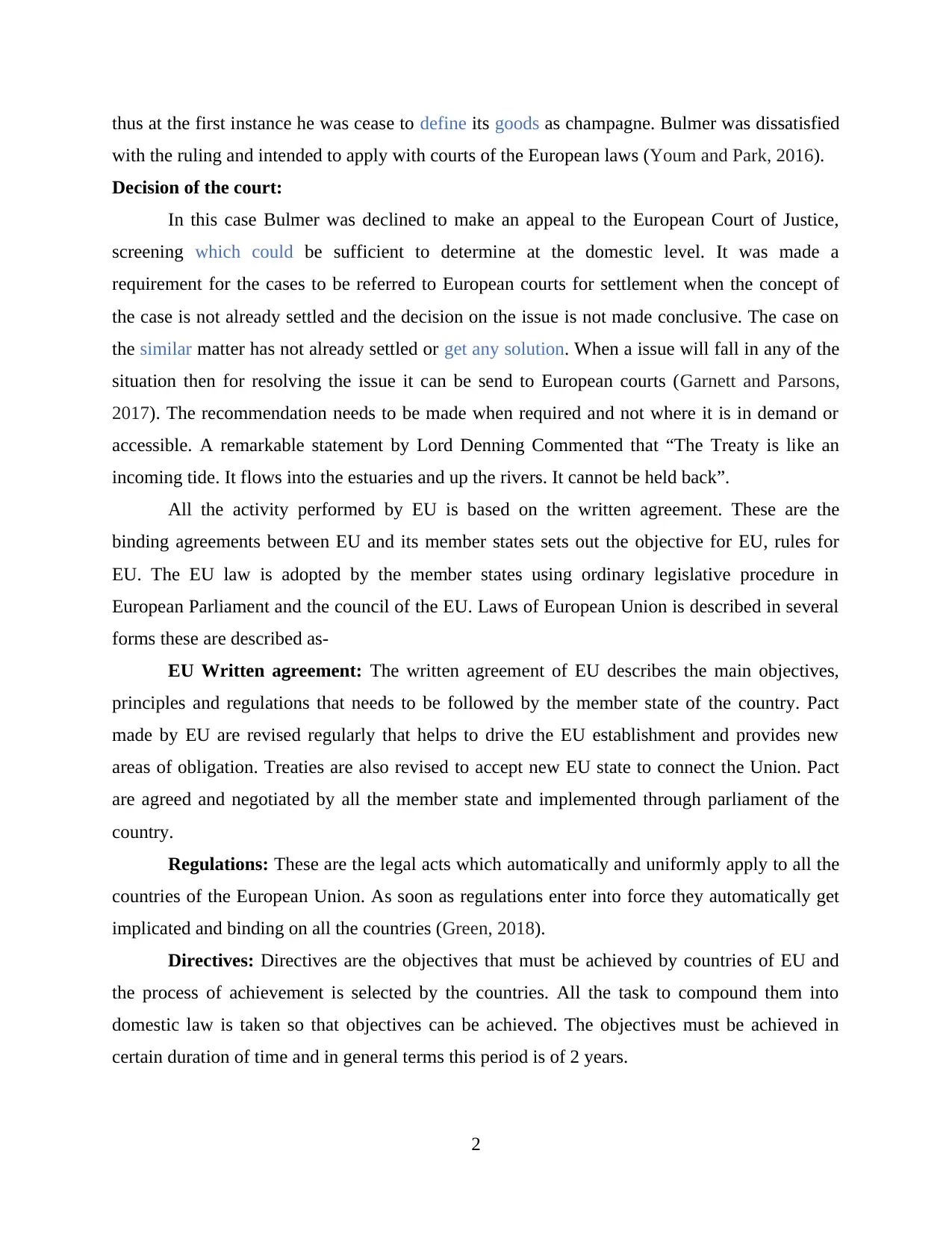
thus at the first instance he was cease to define its goods as champagne. Bulmer was dissatisfied
with the ruling and intended to apply with courts of the European laws (Youm and Park, 2016).
Decision of the court:
In this case Bulmer was declined to make an appeal to the European Court of Justice,
screening which could be sufficient to determine at the domestic level. It was made a
requirement for the cases to be referred to European courts for settlement when the concept of
the case is not already settled and the decision on the issue is not made conclusive. The case on
the similar matter has not already settled or get any solution. When a issue will fall in any of the
situation then for resolving the issue it can be send to European courts (Garnett and Parsons,
2017). The recommendation needs to be made when required and not where it is in demand or
accessible. A remarkable statement by Lord Denning Commented that “The Treaty is like an
incoming tide. It flows into the estuaries and up the rivers. It cannot be held back”.
All the activity performed by EU is based on the written agreement. These are the
binding agreements between EU and its member states sets out the objective for EU, rules for
EU. The EU law is adopted by the member states using ordinary legislative procedure in
European Parliament and the council of the EU. Laws of European Union is described in several
forms these are described as-
EU Written agreement: The written agreement of EU describes the main objectives,
principles and regulations that needs to be followed by the member state of the country. Pact
made by EU are revised regularly that helps to drive the EU establishment and provides new
areas of obligation. Treaties are also revised to accept new EU state to connect the Union. Pact
are agreed and negotiated by all the member state and implemented through parliament of the
country.
Regulations: These are the legal acts which automatically and uniformly apply to all the
countries of the European Union. As soon as regulations enter into force they automatically get
implicated and binding on all the countries (Green, 2018).
Directives: Directives are the objectives that must be achieved by countries of EU and
the process of achievement is selected by the countries. All the task to compound them into
domestic law is taken so that objectives can be achieved. The objectives must be achieved in
certain duration of time and in general terms this period is of 2 years.
2
with the ruling and intended to apply with courts of the European laws (Youm and Park, 2016).
Decision of the court:
In this case Bulmer was declined to make an appeal to the European Court of Justice,
screening which could be sufficient to determine at the domestic level. It was made a
requirement for the cases to be referred to European courts for settlement when the concept of
the case is not already settled and the decision on the issue is not made conclusive. The case on
the similar matter has not already settled or get any solution. When a issue will fall in any of the
situation then for resolving the issue it can be send to European courts (Garnett and Parsons,
2017). The recommendation needs to be made when required and not where it is in demand or
accessible. A remarkable statement by Lord Denning Commented that “The Treaty is like an
incoming tide. It flows into the estuaries and up the rivers. It cannot be held back”.
All the activity performed by EU is based on the written agreement. These are the
binding agreements between EU and its member states sets out the objective for EU, rules for
EU. The EU law is adopted by the member states using ordinary legislative procedure in
European Parliament and the council of the EU. Laws of European Union is described in several
forms these are described as-
EU Written agreement: The written agreement of EU describes the main objectives,
principles and regulations that needs to be followed by the member state of the country. Pact
made by EU are revised regularly that helps to drive the EU establishment and provides new
areas of obligation. Treaties are also revised to accept new EU state to connect the Union. Pact
are agreed and negotiated by all the member state and implemented through parliament of the
country.
Regulations: These are the legal acts which automatically and uniformly apply to all the
countries of the European Union. As soon as regulations enter into force they automatically get
implicated and binding on all the countries (Green, 2018).
Directives: Directives are the objectives that must be achieved by countries of EU and
the process of achievement is selected by the countries. All the task to compound them into
domestic law is taken so that objectives can be achieved. The objectives must be achieved in
certain duration of time and in general terms this period is of 2 years.
2
Secure Best Marks with AI Grader
Need help grading? Try our AI Grader for instant feedback on your assignments.

Recommendations: It allows the institution of the union to provide their opinion and to
suggest a procedure in which actions can be taken to achieve legal obligations for whom it appliy
(Terziev, Petkov and Dragomir, 2018).
Options: A option is an instrument that allows the institution of the union to make a
statement that is not legally binding on the member state for adaptation.
Delegated acts: These are the lawfully costive acts that enhances competence of the
committee to support or amend non-essential parts of the European Union law. This helps in
making the legal system more effecting by minimising the size of unnecessary statements and
laws.
Implementing acts: These are the acts that are legally implemented by the union on its
member states to guarantee that the laws of the union are implemented in the same manner
(Habermas, 2012).
In definite region the EU alone has exclusive power to pass the laws for all the member
states. The role of the member states of the union is restricted for applying the laws up to
authorise them so. Certain areas such as Custom union, competition rules, monetary policy, trade
and marine rules all are regulated by EU laws. There are definite areas where both EU and
member states can make the laws such as single market, agriculture, fisheries, environment,
transport, energy etc. In certain areas European Union plays important role that is not generally
performed by them and it is beyond the treaties. The effective role must be played when the
required concern belongs to nation.
Direct applicability of EU laws talks about whether laws requires a domestic legislature
to act out statute law to create law in member state. EU pact and EU legislations are instantly
relevant. For implication of the laws no act of the parliament is required, once a treaty is signed
by Council of Ministers it intently becomes valid to countries which are involved. Directives of
EU are not directly applicable and requires some legislation to convert it into national law
(Kaczorowska-Ireland, 2012). EU laws refers to direct effect that means whether people can
depend on European Union in local courts. Mainly two kind of effect are there one is horizontal
and other is vertical.
Vertical effect refers that EU legislations could be used against a state which is a
member.
Horizontal effect means that EU legislations can be used against another individual.
3
suggest a procedure in which actions can be taken to achieve legal obligations for whom it appliy
(Terziev, Petkov and Dragomir, 2018).
Options: A option is an instrument that allows the institution of the union to make a
statement that is not legally binding on the member state for adaptation.
Delegated acts: These are the lawfully costive acts that enhances competence of the
committee to support or amend non-essential parts of the European Union law. This helps in
making the legal system more effecting by minimising the size of unnecessary statements and
laws.
Implementing acts: These are the acts that are legally implemented by the union on its
member states to guarantee that the laws of the union are implemented in the same manner
(Habermas, 2012).
In definite region the EU alone has exclusive power to pass the laws for all the member
states. The role of the member states of the union is restricted for applying the laws up to
authorise them so. Certain areas such as Custom union, competition rules, monetary policy, trade
and marine rules all are regulated by EU laws. There are definite areas where both EU and
member states can make the laws such as single market, agriculture, fisheries, environment,
transport, energy etc. In certain areas European Union plays important role that is not generally
performed by them and it is beyond the treaties. The effective role must be played when the
required concern belongs to nation.
Direct applicability of EU laws talks about whether laws requires a domestic legislature
to act out statute law to create law in member state. EU pact and EU legislations are instantly
relevant. For implication of the laws no act of the parliament is required, once a treaty is signed
by Council of Ministers it intently becomes valid to countries which are involved. Directives of
EU are not directly applicable and requires some legislation to convert it into national law
(Kaczorowska-Ireland, 2012). EU laws refers to direct effect that means whether people can
depend on European Union in local courts. Mainly two kind of effect are there one is horizontal
and other is vertical.
Vertical effect refers that EU legislations could be used against a state which is a
member.
Horizontal effect means that EU legislations can be used against another individual.
3

There are several case that are already held reflecting the importance of European Union
law and its implementation in the domestic law of the country. The case of Francovich v Italy
[1991], under Insolvency Protection Directive member countries of the European Unions are
provided to react in certain manner that is defined in the domestic laws of the country. This leads
to provide a negligible level of insurance for workers who had unpaid wages if their employees
went insolvent. A company in Italy has become insolvent and employees remain unpaid. The
directive to protect against insolvent was not implemented in national law of the country
(Francovich v Italy, 1991 ). Then a ruling of the court governing the European Union is provided
on this which reflects that loss suffered by an individual by the reason of the member state then
must be compensated by the state.
Horizontal direct effect to support European legislations can be used against individual
could be seen through the case of Defrenne v Sabena [1976]. The applier brought an act before
the tribunal for compensation for the loss she incurred in terms of her pay, allowance on
termination of contract and pension. The European Commission Jurisdiction held that the equal
pay provision of Article 119 had both social and economic aim. As per the regulations of
European union each employee must be paid equally for the work performed by them. This law
will not only to member states but also to individual employers those who have employees for
performing business activities. It will be advisable for individuals to rely on treaties that helps to
provide them solutions for any case. (Defrenne v Sabena, 1976).
UK parliament is the highest authority for formation of laws in the country. As UK is the
member state of the EU it can be seen that laws of the union is also applicable on the UK. EU
laws affects the sovereignty or supremacy of the UK parliament. This is because a detailed
elaboration of EU law and its implementations are explained with some landmark case laws.
Legislations provided by the EU are binding and overrules legal system combined with rules and
principles of United Kingdom. To settle each issue and to amend UK laws EU laws will be taken
as basis and guidelines to implement the required changes (Schön, 2013).
CONCLUSION
The given report and issues addressed in this report brings a conclusion that European
Union laws are binding on its member states. These laws serves as an important source of law
formation in the country. EU laws are implemented in different forms and they direct affect the
applicability of the laws in the country. Laws provided by the European Union supersedes laws
4
law and its implementation in the domestic law of the country. The case of Francovich v Italy
[1991], under Insolvency Protection Directive member countries of the European Unions are
provided to react in certain manner that is defined in the domestic laws of the country. This leads
to provide a negligible level of insurance for workers who had unpaid wages if their employees
went insolvent. A company in Italy has become insolvent and employees remain unpaid. The
directive to protect against insolvent was not implemented in national law of the country
(Francovich v Italy, 1991 ). Then a ruling of the court governing the European Union is provided
on this which reflects that loss suffered by an individual by the reason of the member state then
must be compensated by the state.
Horizontal direct effect to support European legislations can be used against individual
could be seen through the case of Defrenne v Sabena [1976]. The applier brought an act before
the tribunal for compensation for the loss she incurred in terms of her pay, allowance on
termination of contract and pension. The European Commission Jurisdiction held that the equal
pay provision of Article 119 had both social and economic aim. As per the regulations of
European union each employee must be paid equally for the work performed by them. This law
will not only to member states but also to individual employers those who have employees for
performing business activities. It will be advisable for individuals to rely on treaties that helps to
provide them solutions for any case. (Defrenne v Sabena, 1976).
UK parliament is the highest authority for formation of laws in the country. As UK is the
member state of the EU it can be seen that laws of the union is also applicable on the UK. EU
laws affects the sovereignty or supremacy of the UK parliament. This is because a detailed
elaboration of EU law and its implementations are explained with some landmark case laws.
Legislations provided by the EU are binding and overrules legal system combined with rules and
principles of United Kingdom. To settle each issue and to amend UK laws EU laws will be taken
as basis and guidelines to implement the required changes (Schön, 2013).
CONCLUSION
The given report and issues addressed in this report brings a conclusion that European
Union laws are binding on its member states. These laws serves as an important source of law
formation in the country. EU laws are implemented in different forms and they direct affect the
applicability of the laws in the country. Laws provided by the European Union supersedes laws
4
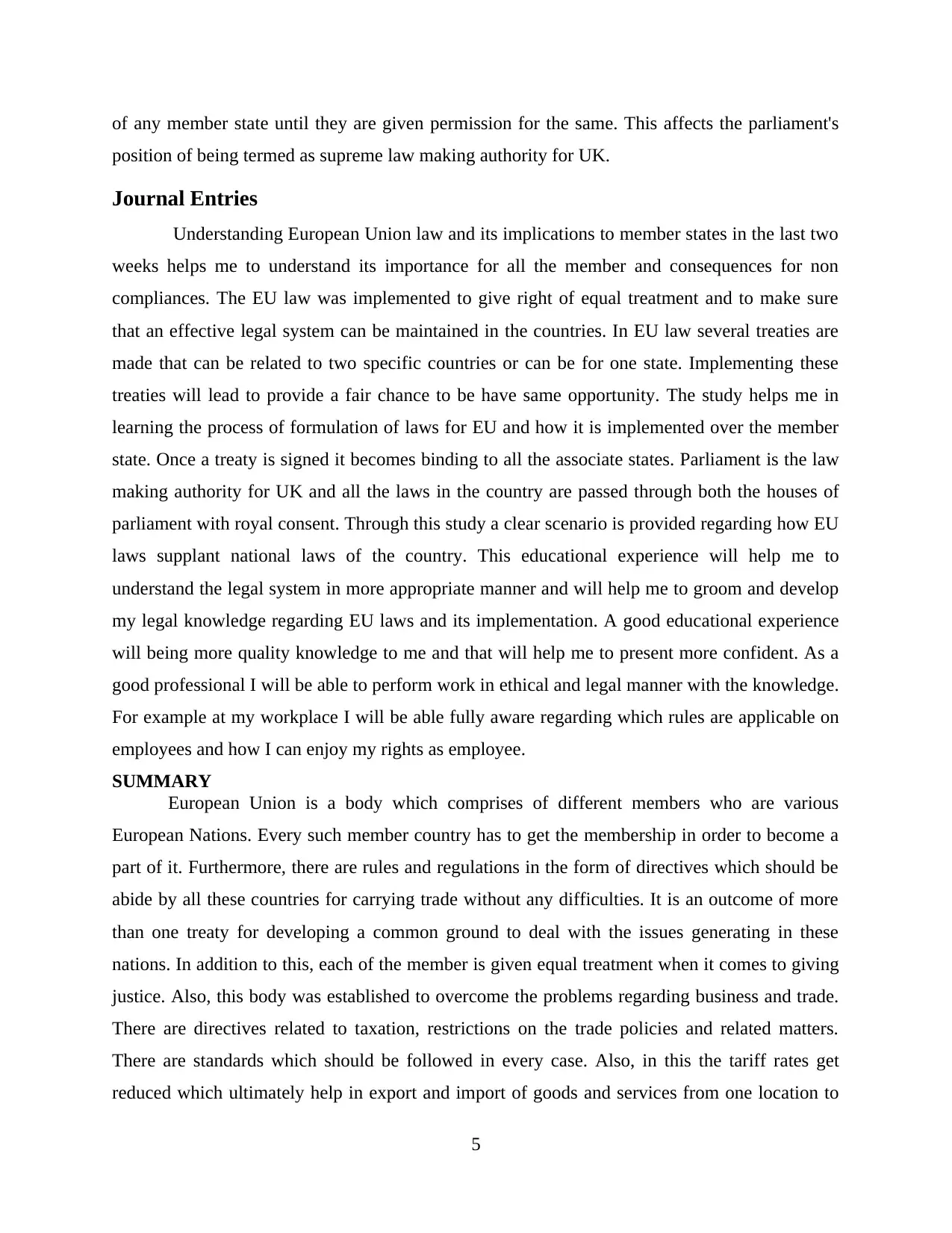
of any member state until they are given permission for the same. This affects the parliament's
position of being termed as supreme law making authority for UK.
Journal Entries
Understanding European Union law and its implications to member states in the last two
weeks helps me to understand its importance for all the member and consequences for non
compliances. The EU law was implemented to give right of equal treatment and to make sure
that an effective legal system can be maintained in the countries. In EU law several treaties are
made that can be related to two specific countries or can be for one state. Implementing these
treaties will lead to provide a fair chance to be have same opportunity. The study helps me in
learning the process of formulation of laws for EU and how it is implemented over the member
state. Once a treaty is signed it becomes binding to all the associate states. Parliament is the law
making authority for UK and all the laws in the country are passed through both the houses of
parliament with royal consent. Through this study a clear scenario is provided regarding how EU
laws supplant national laws of the country. This educational experience will help me to
understand the legal system in more appropriate manner and will help me to groom and develop
my legal knowledge regarding EU laws and its implementation. A good educational experience
will being more quality knowledge to me and that will help me to present more confident. As a
good professional I will be able to perform work in ethical and legal manner with the knowledge.
For example at my workplace I will be able fully aware regarding which rules are applicable on
employees and how I can enjoy my rights as employee.
SUMMARY
European Union is a body which comprises of different members who are various
European Nations. Every such member country has to get the membership in order to become a
part of it. Furthermore, there are rules and regulations in the form of directives which should be
abide by all these countries for carrying trade without any difficulties. It is an outcome of more
than one treaty for developing a common ground to deal with the issues generating in these
nations. In addition to this, each of the member is given equal treatment when it comes to giving
justice. Also, this body was established to overcome the problems regarding business and trade.
There are directives related to taxation, restrictions on the trade policies and related matters.
There are standards which should be followed in every case. Also, in this the tariff rates get
reduced which ultimately help in export and import of goods and services from one location to
5
position of being termed as supreme law making authority for UK.
Journal Entries
Understanding European Union law and its implications to member states in the last two
weeks helps me to understand its importance for all the member and consequences for non
compliances. The EU law was implemented to give right of equal treatment and to make sure
that an effective legal system can be maintained in the countries. In EU law several treaties are
made that can be related to two specific countries or can be for one state. Implementing these
treaties will lead to provide a fair chance to be have same opportunity. The study helps me in
learning the process of formulation of laws for EU and how it is implemented over the member
state. Once a treaty is signed it becomes binding to all the associate states. Parliament is the law
making authority for UK and all the laws in the country are passed through both the houses of
parliament with royal consent. Through this study a clear scenario is provided regarding how EU
laws supplant national laws of the country. This educational experience will help me to
understand the legal system in more appropriate manner and will help me to groom and develop
my legal knowledge regarding EU laws and its implementation. A good educational experience
will being more quality knowledge to me and that will help me to present more confident. As a
good professional I will be able to perform work in ethical and legal manner with the knowledge.
For example at my workplace I will be able fully aware regarding which rules are applicable on
employees and how I can enjoy my rights as employee.
SUMMARY
European Union is a body which comprises of different members who are various
European Nations. Every such member country has to get the membership in order to become a
part of it. Furthermore, there are rules and regulations in the form of directives which should be
abide by all these countries for carrying trade without any difficulties. It is an outcome of more
than one treaty for developing a common ground to deal with the issues generating in these
nations. In addition to this, each of the member is given equal treatment when it comes to giving
justice. Also, this body was established to overcome the problems regarding business and trade.
There are directives related to taxation, restrictions on the trade policies and related matters.
There are standards which should be followed in every case. Also, in this the tariff rates get
reduced which ultimately help in export and import of goods and services from one location to
5
Paraphrase This Document
Need a fresh take? Get an instant paraphrase of this document with our AI Paraphraser

another. Apart from this, some of the cases have been resolved under this which can be
considered for regulating the rights and get the conclusion. Hence, the application of the
directives should be made for the benefits of countries who have the membership.
6
considered for regulating the rights and get the conclusion. Hence, the application of the
directives should be made for the benefits of countries who have the membership.
6
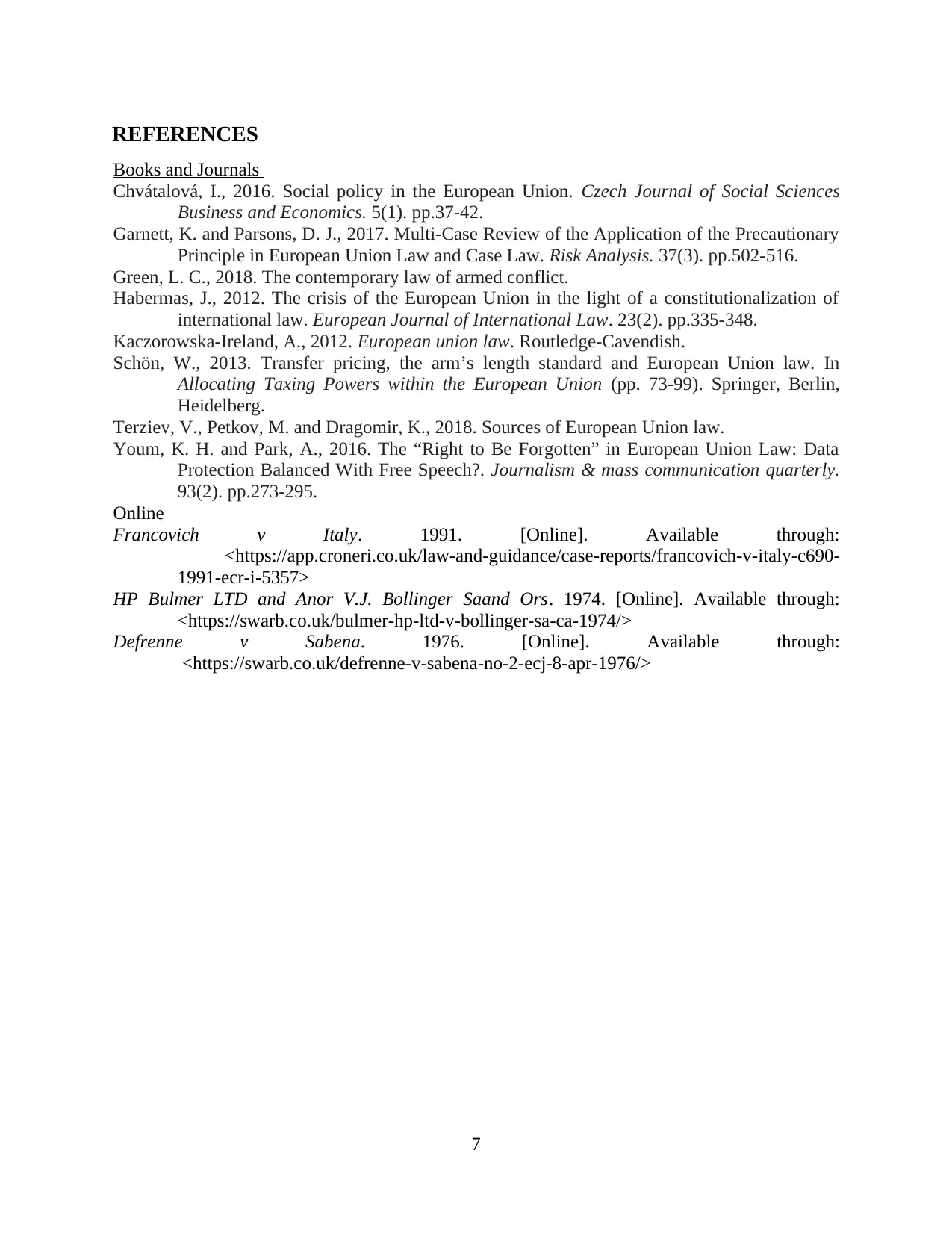
REFERENCES
Books and Journals
Chvátalová, I., 2016. Social policy in the European Union. Czech Journal of Social Sciences
Business and Economics. 5(1). pp.37-42.
Garnett, K. and Parsons, D. J., 2017. Multi‐Case Review of the Application of the Precautionary
Principle in European Union Law and Case Law. Risk Analysis. 37(3). pp.502-516.
Green, L. C., 2018. The contemporary law of armed conflict.
Habermas, J., 2012. The crisis of the European Union in the light of a constitutionalization of
international law. European Journal of International Law. 23(2). pp.335-348.
Kaczorowska-Ireland, A., 2012. European union law. Routledge-Cavendish.
Schön, W., 2013. Transfer pricing, the arm’s length standard and European Union law. In
Allocating Taxing Powers within the European Union (pp. 73-99). Springer, Berlin,
Heidelberg.
Terziev, V., Petkov, M. and Dragomir, K., 2018. Sources of European Union law.
Youm, K. H. and Park, A., 2016. The “Right to Be Forgotten” in European Union Law: Data
Protection Balanced With Free Speech?. Journalism & mass communication quarterly.
93(2). pp.273-295.
Online
Francovich v Italy. 1991. [Online]. Available through:
<https://app.croneri.co.uk/law-and-guidance/case-reports/francovich-v-italy-c690-
1991-ecr-i-5357>
HP Bulmer LTD and Anor V.J. Bollinger Saand Ors. 1974. [Online]. Available through:
<https://swarb.co.uk/bulmer-hp-ltd-v-bollinger-sa-ca-1974/>
Defrenne v Sabena. 1976. [Online]. Available through:
<https://swarb.co.uk/defrenne-v-sabena-no-2-ecj-8-apr-1976/>
7
Books and Journals
Chvátalová, I., 2016. Social policy in the European Union. Czech Journal of Social Sciences
Business and Economics. 5(1). pp.37-42.
Garnett, K. and Parsons, D. J., 2017. Multi‐Case Review of the Application of the Precautionary
Principle in European Union Law and Case Law. Risk Analysis. 37(3). pp.502-516.
Green, L. C., 2018. The contemporary law of armed conflict.
Habermas, J., 2012. The crisis of the European Union in the light of a constitutionalization of
international law. European Journal of International Law. 23(2). pp.335-348.
Kaczorowska-Ireland, A., 2012. European union law. Routledge-Cavendish.
Schön, W., 2013. Transfer pricing, the arm’s length standard and European Union law. In
Allocating Taxing Powers within the European Union (pp. 73-99). Springer, Berlin,
Heidelberg.
Terziev, V., Petkov, M. and Dragomir, K., 2018. Sources of European Union law.
Youm, K. H. and Park, A., 2016. The “Right to Be Forgotten” in European Union Law: Data
Protection Balanced With Free Speech?. Journalism & mass communication quarterly.
93(2). pp.273-295.
Online
Francovich v Italy. 1991. [Online]. Available through:
<https://app.croneri.co.uk/law-and-guidance/case-reports/francovich-v-italy-c690-
1991-ecr-i-5357>
HP Bulmer LTD and Anor V.J. Bollinger Saand Ors. 1974. [Online]. Available through:
<https://swarb.co.uk/bulmer-hp-ltd-v-bollinger-sa-ca-1974/>
Defrenne v Sabena. 1976. [Online]. Available through:
<https://swarb.co.uk/defrenne-v-sabena-no-2-ecj-8-apr-1976/>
7
1 out of 9
Related Documents
Your All-in-One AI-Powered Toolkit for Academic Success.
+13062052269
info@desklib.com
Available 24*7 on WhatsApp / Email
![[object Object]](/_next/static/media/star-bottom.7253800d.svg)
Unlock your academic potential
© 2024 | Zucol Services PVT LTD | All rights reserved.





